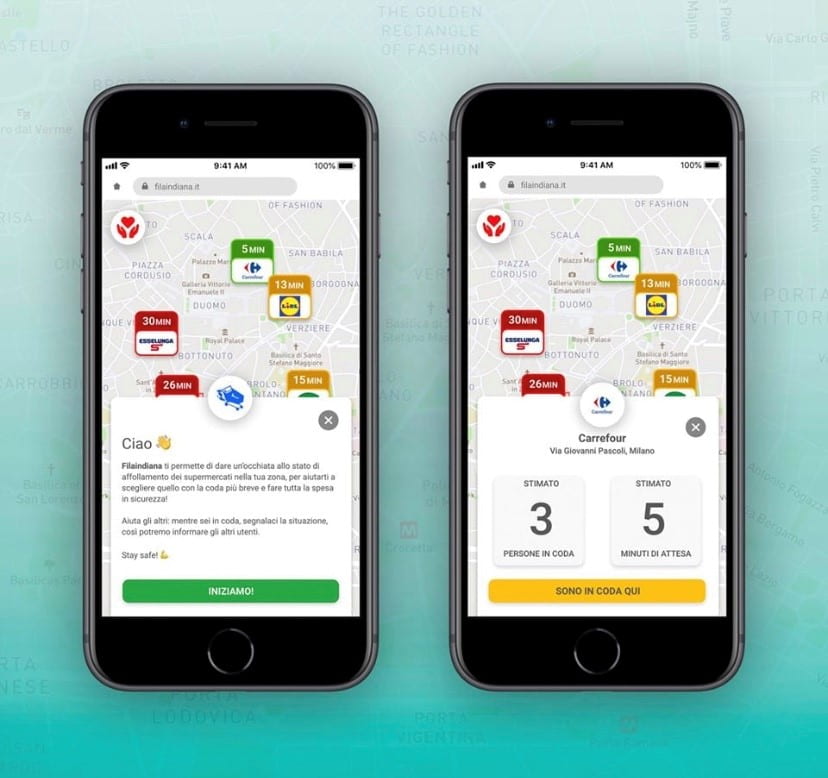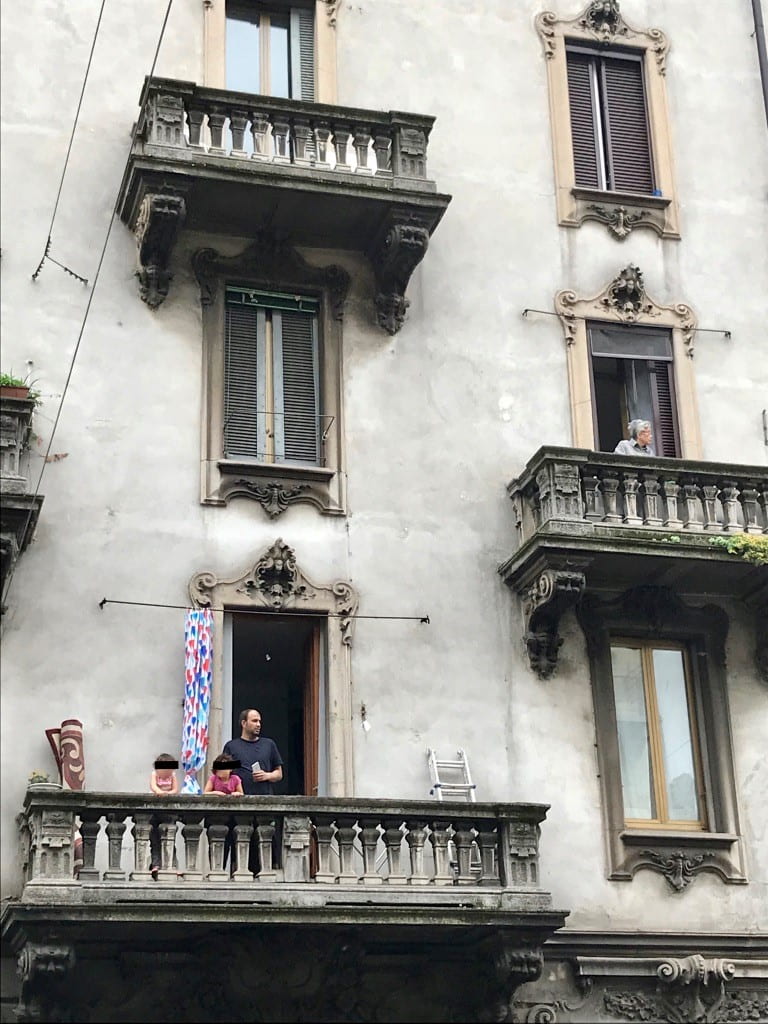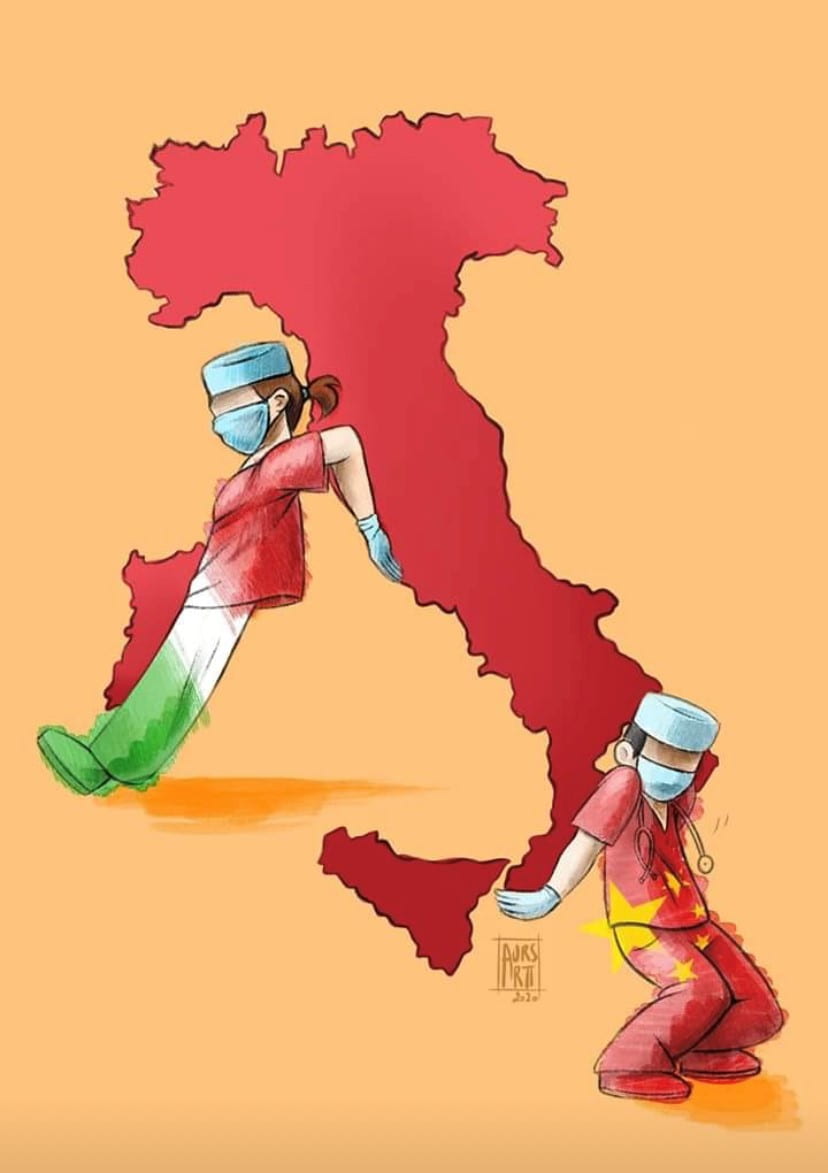Social Distancing vs. Digital Social Participation in Milan: Notes from fieldwork and after
By Shireen Walton, on 23 March 2020
The coronavirus pandemic has significantly affected the lives of people across the world, with Italy currently experiencing among the severest consequences of the virus. Between 2018 and 2019, I conducted 16 months of fieldwork in Milan, where I had been studying issues of digital social participation, care and communication via smartphones in contexts of social isolation and marginalisation, loneliness, old age and frailty. Since then, I have remained in virtual contact with research participants in the community via WhatsApp and other modes of communication, and today, I am witnessing, every day, how people learn to live and care for one another in these extraordinary times.
In recent weeks, the news and social media have reported on high-profile signs of public-facing solidarity between people in Italy, such as the balcony and rooftop singing across apartment blocks that captured global media attention and made contemporary Italian quarantine sociability go viral. However, in addition to these examples, there are broader and subtler practices of everyday digital communication practices that are continuing to characterise and sustain daily life in Italy under quarantine, many of which can be understood as follows.
1. Visual digital practices of care and communication
A dominant form of communication involves routine visual communication practices such as memes to wish people a good day, wishing them a nice meal, or saying good night, stickers and emojis sent throughout the day, where the frequency of sending and receiving these makes many people feel various combinations of closer, better, safer, expressing care and feeling cared for.
For example, Elena (50), who is separated from her husband and lives by herself, is reserved and private, but affectionate in her social relations. She communicates on WhatsApp mostly via memes: ‘I send up to seven or eight memes a day, mostly to friends but also to particular family members who would understand them, one of my sisters, a cousin who lives in America…’
Sending memes is not always about getting a response, and this does not seem to bother Elena. Rather, it is a way of talking without always having to call someone or to disturb them in order to engage in dialogue. Today, amidst the crisis, Elena continues to send good morning and good night memes to friends and family, including myself, alongside videos and links during the day, which reflect a range of emotions from light-hearted and satirical to overtly emotional expressions of solidarity. The key difference is that in contrast to the past, hearing back from people now really matters to Elena as she passes the days by herself, with her cat, in her one-bedroom apartment in central NoLo, under quarantine.
Often these individual sharing practices reflect currents within the wider national emotional response, as in the following image, which recently emerged as a visual representation of the crisis. The mural was painted on a wall of the Papa Giovanni XXIII Hospital in Bergamo, Lombardy – one of the worst affected cities and regions – by Italian artist Franco Rivolli. It depicts a nurse wearing a face mask, with wings on her back and cradling Italy. Over the last couple of weeks the image has taken on a digital form online, being shared across Italian social media, profile pictures, and cover photos. Together with its caption, ‘A tutti voi, grazie’ (To you all, thank you’), addressed to front line healthcare professionals, it draws people into its sentiment of national care and gratitude. The image itself invokes strong visual themes in Italian culture, politics and society such as the religious iconography of the Madonna and child and idyll of the Mother as principal carer, linked to care and protect of La Madrepatria (Motherland).
Another popular video, linking female care with the crisis has been images and videos of Italian grandmothers, who hold a certain sacred space in Italian culture and public imagination as guardians of the family, again which blends with notions of the nation-state as la famiglia. The following video, which went viral in early March, shows an Italian Nonna (Grandmother) giving advice on how to deal with Coronavirus, beyond fear, and to make the best of domestic time spent at home under quarantine.
These themes can also extend to a global sense of common humanity, as in the following meme, which acknowledges the lessons learnt from the crisis in China, depicting healthcare workers from China and Italy holding up Italy, together.
2. Being together & doing things together online
Equally important in the present moment is the development of group activities and doing things together (‘fare cose insieme’) in digital and virtual ways, ranging from members of church congregations praying together on church WhatsApp groups, issuing timetables for online schooling programmes, facilitating yoga and gym classes from the home, bands rehearsing together across different cities, choirs singing together, as well as whole generations of families dining together in real-time co-presence via WhatsApp video and Skype. There are also references to historical precedents of struggle and survival, such as during WWII, as the most widespread hashtag in Italy at present attests, ‘andrà tutto bene’ (‘it’ll all be ok’).
3. Informing and Information
Information is of high value under quarantine, and digital platform services are being developed and curated to provide many kinds of information. Visual forms are constantly being developed for the dissemination of health and safety advice as in this example from the Ministry of Health about protocols to help prevent the spread of the virus.
In other examples, an app has been created in Milan to let people know in real time where supermarkets queues are the shortest – the supermarket, along with the pharmacy, being among the only officially permitted trips one can make outside of the home at the moment in Italy. In a recent article based on NoLo in Milan, The Economist noted that these supermarket queues are developing their own reputation for dating.

Screengrabs of the Italian supermarket app, which shows real-time queues in various shops near the user.
As in most regions, googling of health symptoms was well established in Milan. The main new development in the context of the crisis has been a significant pushback by medical authorities (not witnessed in the last two years during my fieldwork) against ‘fake health information’, with health professionals taking to the Internet to leave messages about what not to believe/what to believe. In one example, the Medical Director from Milan’s Niguarda hospital pleads to the people of Milan, and to the nation, to stop circulating unverified information about Coronavirus, including gossip about what doctors are/are not doing or who they are/are not treating, to groups via social media.

Roberto Fumagalli’s video appeal against fake news. Image source: https://milano.corriere.it/notizie/cronaca/20_marzo_11/coronavirus-milano-video-appello-denuncia-dell-ospedale-niguarda-contro-fake-news-1c2c96b4-639a-11ea-9cf4-1c175ff3bb7c.shtml?refresh_ce-cp
These kinds of urgent and direct responses amidst peak crisis in Italy mark a new form of official engagement with digital avenues of communication within the SSN (Servizio Sanitario Nazionale), which were not largely present in this way before the initial phase of the pandemic.
4. Ageing/living without smartphones
All of this online activity begs the question of how people cope when they do not have access to smartphones. Beatrice is 83, lives with her husband, and has two sons in their 50s and 60s, and four grandchildren. She does not have a smartphone, feeling that “the house phone gives us (her and her husband) everything we need”. Beatrice’s sons call home up to three times a day to check in with Beatrice and her husband, their father. It is her house phone that has become her “constant companion” – a benign object, a familiar friend that she knows well, something that has served her for many years.
The family has orientated itself around Beatrice’s preferences.
By contrast Claudia, a widow and grandmother of two, who at 81 is just as much attached to her smartphone as she is to social media, through which she has met and connected with dozens of people in the NoLo community, particularly younger people – through which today, sustains her social life in quarantine, where she cannot physically see her daughter, son-in-law and grandchildren.
5. Digital solidarities and digital + socioeconomic divides
Digital social participation is of course heavily situated in socioeconomic context and continues to be so in times of crisis, where digital communication and care becomes even more constricted for those who have no home WiFi. In my Milan research, this included many families of asylum seekers and migrants living in apartments let by social services. In such cases, public WiFi hot spots such as stations, cafes and bars and public libraries would be relied upon for Internet connection, accessed via an individual providing their Codice Fiscale (Italian tax code, akin to a National Insurance Number in the UK or Social Security Number in the US). In response to questions of digital vulnerability, over the last few weeks, the Italian Ministry for Technological Innovation and Digitization has put together a ‘Digital Solidarity’ campaign, whereby a range of services such as free online newspapers, faster internet and access to e-learning platforms can be accessed due to support from companies and organisations, including telecom network providers that can sign up to provide their services. This builds on Milan’s self-conscious development of a reputation as a modern ‘smart city’.
Conclusion
Examining the community of NoLo, Milan under quarantine from afar, but remaining close via WhatsApp groups and social media, it seems that many existing patterns of sociability in this context have in fact extended to the digital from groups and patterns already firmly in place in people’s offline/wider social lives. These are met by top-down government, regional and city-led services, instructions and restrictions – one result is the emergence of a shared sense of social solidarity, expressed in a variety of forms, including popular hashtags such as #iorestoacasa (I’m staying at home), and #andràtuttobene, while others who are not engaging in these digital ways under quarantine seek, and/or are met with, crucial alternative vehicles of care and contact at this time – from regular house phone calling by relatives, friends and neighbours, to food shopping delivered to the door, to initiatives to help people connect to the Internet and access faster connections, and online lessons aimed at older adults on how to download and use Skype on a PC desktop.
This is indeed a digital moment for Milan, in an already digitally-developing city, and, like the rest of the world, my research participants in NoLo, digitally connected to varying degrees, are figuring out how to live and take care of each other amidst this unprecedented crisis. For a significant number of people, digital social participation feels “vitale”* in connecting to others and the world, and sustaining countless days and nights in quarantine. In the meantime, much care and attention needs to be paid to particularly vulnerable members of society who are not within the digital scope of contemporary care and communication practices and platforms, as the country utilises existing and novel ways to navigate the extraordinary necessity of being together apart, until further notice.
*vital, as ‘of, or belonging to, life’, from the Latin/Italian vita for life.
 Close
Close


















